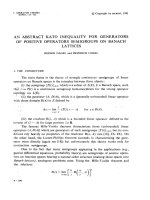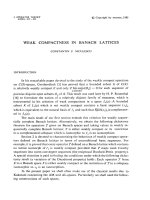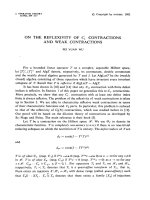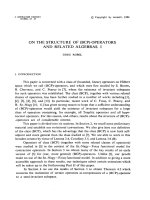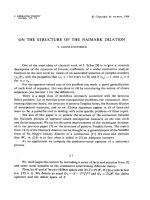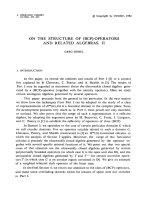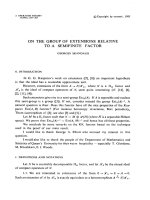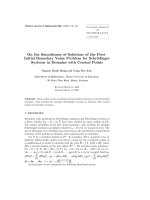Báo cáo toán học: "On the Proof of a Theorem of P´lfy a" doc
Bạn đang xem bản rút gọn của tài liệu. Xem và tải ngay bản đầy đủ của tài liệu tại đây (79.38 KB, 4 trang )
On the Proof of a Theorem of P´alfy
Edward Dobson
Department of Mathematics and Statistics
Mississippi State University
PO Drawer MA
Mississippi State, MS 39762 USA
Submitted: Mar 24, 2006; Accepted: Oct 10, 2006; Published: Oct 19, 2006
Mathematics Subject Classification: 05E99
Abstract
P´alfy proved that a group G is a CI-group if and only if |G| = n where either
gcd(n, ϕ(n)) = 1 or n = 4, where ϕ is Euler’s phi function. We simplify the proof
of “if gcd(n, ϕ(n)) = 1 and G is a group of order n, then G is a CI-group”.
In 1987, P´alfy [6] proved perhaps the most well-known result pertaining to the Cayley
isomorphism problem. Namely, that a group G of order n is a CI-group if and only if
either gcd(n, ϕ(n)) = 1 or n = 4, where ϕ is Euler’s phi function. It is worth noting that
every group of order n is cyclic if and only if gcd(n, ϕ(n)) = 1. It is the purpose of this
note to simplify some parts of P´alfy’s original proof.
Definition 1 Let G be a group and define g
L
: G → G by g
L
(x) = gx. Let G
L
=
{g
L
: g ∈ G}. Then G
L
is the left-regular representation of G. (It is a subgroup of the
symmetric group S
G
of all permutations on G.) We define a Cayley object of G to be
a combinatorial object X (e.g. digraph, graph, design, code) such that G
L
≤ Aut(X),
where Aut(X) is the automorphism group of X (note that this implies that the vertex set
of X is in fact G). To say that G is a CI-group means that if X and Y are any Cayley
objects of G such that X is isomorphic to Y , then some group automorphism of G is an
isomorphism from X to Y .
CI-groups are characterized by the following result due to Babai [1].
Lemma 1 For a group G, the following are equivalent:
1. G is a CI-group,
2. for every γ ∈ S
G
, there exists δ ∈ G
L
, γ
−1
G
L
γ such that δ
−1
γ
−1
G
L
γδ = G
L
.
the electronic journal of combinatorics 13 (2006), #N16 1
We will not simplify all of P´alfy’s proof, so it will be worthwhile to discuss exactly
which part of his proof we will simplify. First, we will not deal with groups G such that
|G| = 4 at all. Second, we will only be concerned with showing that if gcd(n, ϕ(n)) = 1,
then Z
n
is a CI-group. Third, P´alfy’s original proof can be broken into two cases, with
the first dealing with the case where (Z
n
)
L
, γ
−1
(Z
n
)
L
γ is doubly-transitive and the
second dealing with the case where (Z
n
)
L
, γ
−1
(Z
n
)
L
γ is imprimitive (note that as Z
n
is a Burnside group [3, Theorem 3.5A] for n composite, these are the only nontrivial
cases). The doubly-transitive case was reduced by P´alfy to the imprimitive case using
the fact that all doubly-transitive groups are known [2], which is a consequence of the
Classification of the Finite Simple Groups. We shall do the same, using P´alfy’s argument.
P´alfy handled the imprimitive case by using a sequence of lemmas (Lemmas 1.1-1.4 in [6])
which, while not overly difficult, do involve some tedious calculations and do not seem
to make transparent why the condition gcd(n, ϕ(n)) = 1 is crucial. We shall show that
Lemma’s 1.2-1.4 of [6] can more or less be replaced by an application of Philip Hall’s
generalization of the Sylow Theorems for solvable groups.
Let π be a set of primes. A π-group is a group G such that every prime divisor of |G|
is contained in π. A Hall π-subgroup H of G is a subgroup of G such that H is a π-group,
and no prime contained in π divides |G|/|H|. Hall π-subgroups need not exist, but we
remind the reader that Hall’s Theorem [4, Theorem 6.4.1] states that they do exist if G
is solvable, and in that case any two Hall π-subgroups of G are conjugate in G.
Definition 2 Let G be a transitive permutation group of degree mk that admits a com-
plete block system B of m blocks of size k. If g ∈ G, then g permutes the m blocks of B
and hence induces a permutation in the symmetric group S
m
, which we denote by g/B.
We define G/B = {g/B : g ∈ G}. Let fix
G
(B) = {g ∈ G : g(B) = B for every B ∈ B},
and for B ∈ B, let Stab
G
(B) = {g ∈ G : g(B) = B}.
We shall use P´alfy’s notation, repeated here for convenience. Let x be the n-cycle
(0 1 . . . n − 1) (so that x = (Z
n
)
L
) and y any conjugate of x in S
n
such that x, y
admits a complete block system of m blocks of size k. Let x
m
= z
0
z
1
· · · z
m−1
where each
z
i
is a k-cycle that permutes i. Finally, let P = z
i
: i ∈ Z
m
. The following result
combines Lemmas 1.2, 1.3, and 1.4 of [6].
Lemma 2 If x, y admits a complete block system B with m blocks of size k such that
y
m
∈ P , Z
m
is a CI-group, and gcd(m, k · ϕ(k)) = 1, then y is conjugate to x in x, y.
Proof. As x and y are abelian, and a transitive abelian subgroup is regular [3,
Theorem 4.2A (v)], we have that fix
x
(B) and fix
y
(B) have order k and x/B, y/B
are cyclic of order m. As Z
m
is a CI-group, by Lemma 1, there exists δ
1
∈ x, y/B such
that δ
−1
1
yδ
1
/B = x/B. We thus assume without loss of generality that y/B = x/B.
For i ∈ Z
m
, we have that x
−1
z
i
x = z
σ(i)
for some σ ∈ S
m
and, as y
m
∈ P and y is
abelian, we also have that y
−1
z
i
y = z
a
i
δ(i)
for some δ ∈ S
m
and a
i
∈ Z
∗
k
. We conclude that
both x and y normalize P , so that x and y normalize P
= P ∩ x, y. Thus P
x, y.
Hence P
Stab
x,y
(B), B ∈ B, so that Stab
x,y
(B)|
B
is a transitive group of degree k and
the electronic journal of combinatorics 13 (2006), #N16 2
contains a normal regular abelian subgroup of degree k. By [3, Corollary 4.2B], we have
that Stab
x,y
(B)|
B
is isomorphic to the semidirect product Aut(Z
k
) Z
k
= N(k). It is
well known that Aut(Z
k
) is solvable of order ϕ(k), so that N(k) is solvable of order ϕ(k)·k.
By the Embedding Theorem [5, Theorem 2.6], x, y is permutation group isomorphic to
a subgroup of the wreath product (x, y/B) N(k) so that x, y is permutation group
isomorphic to a subgroup of Z
m
N(k). Hence x, y is solvable. Let π be the set of
primes dividing m. As |Z
m
N(k)| = m · [ϕ(k) · k]
m
and gcd(m, ϕ(k)) = 1 , we have that
gcd(m, [ϕ(k) · k]
m
) = 1. Thus x
k
and y
k
are Hall π-subgroups of x, y and by Hall’s
Theorem are conjugate in x, y. We may thus assume without loss of generality that
x
k
= y
k
.
As P
is abelian, y
m
commutes with x
m
. As y
k
= x
k
and y
m
commutes with y
k
,
we have that y
m
also commutes with x
k
. As x
m
, x
k
= x is a transitive abelian group,
and a transitive abelian group is self-centralizing [3, Theorem 4.2A (v)], we have that
y
m
∈ x. As y
k
≤ x, we have that y ≤ x so that y = x.
For completeness, we include the following proof. Note that it is essentially P´alfy’s
original proof, with Lemma 2 replacing Lemmas 1.2, 1.3, and 1.4 of [6].
Theorem 3 (P´alfy) If n is a positive integer and gcd(n, ϕ(n)) = 1, then Z
n
is a CI-
group.
Proof. Let n = p
1
· · · p
r
be the prime factorization of n. (Note that p
1
, . . . , p
r
are
distinct, because n is relatively prime to ϕ(n).) We proceed by induction on r.
If r = 1, then any two regular cyclic subgroups of S
n
are Sylow n-subgroups of S
n
,
and thus are conjugate. The result then follows by Lemma 1.
Assume that the result holds for all n with gcd(n, ϕ(n)) = 1 such that n has r − 1
distinct prime factors. Let n have r ≥ 2 distinct prime factors, and x be as above. Let
y ∈ S
n
be any n-cycle (so that y is conjugate to x in S
n
). As Z
n
is a Burnside group,
by [3, Theorem 3.5A], we have that x, y is either doubly-transitive or imprimitive.
If x, y is imprimitive, admitting a complete block system B of m blocks of size k,
then by [6, Lemma 1.1], there exists y
∈ S
n
such that y
is conjugate of y in x, y and
(y
)
m
∈ P . By Lemma 2, we then have that y
is conjugate to x in x, y
, so that
x is conjugate to y in x, y. By Lemma 1, Z
n
is a CI-group and the result follows by
induction.
If x, y = S
n
, then clearly y is conjugate to x in x, y. If x, y = A
n
, then by
[6, Lemma 3.1] we have that y and x are conjugate in A
n
. Thus if x, y = A
n
or S
n
,
then the result follows by Lemma 1. Otherwise, by [6, Lemma 2.1], there exists a prime
divisor p of n such that the Sylow p-subgroups of x, y have order p. Then x
n/p
and
y
n/p
are Sylow p-subgroups of x, y and are thus conjugate. Hence there exists y
∈ S
n
such that y
is conjugate to y in x, y and (y
)
n/p
= x
n/p
. Then x
n/p
x, y
, and so
x, y
admits a complete block system B consisting of n/p blocks of size p, reducing this
case to the imprimitive case above. The result then follows by induction.
Acknowledgement: The author would like to thank Dave Witte Morris of the Univer-
sity of Lethbridge for several useful discussions concerning this note. The author is also
the electronic journal of combinatorics 13 (2006), #N16 3
indebted to Dave Witte Morris and Joy Morris for their hospitality at the University of
Lethbridge where this work was done.
References
[1] L. Babai, Isomorphism problem for a class of point-symmetric structures, Acta Math.
Sci. Acad. Hung. 29 (1977), 329-336.
[2] P. J. Cameron, Finite permutation groups and finite simple groups, Bull. London
Math. Soc. 13 (1981) 1–22.
[3] J. D. Dixon, and B. Mortimer, Permutation Groups, Springer-Verlag New York,
Berlin, Heidelberg, Graduate Texts in Mathematics, 163, 1996.
[4] D. Gorenstein, Finite Groups, Chelsea Publishing Co., New York, 1968.
[5] J. D. P. Meldrum, Wreath Products of Groups and Semigroups, Pitman Monographs
and Surveys in Pure and Applied Mathematics, 74, Longman, Harlow, 1995.
[6] P. P. P´alfy, Isomorphism problem for relational structures with a cyclic automor-
phism, Europ. J. Comb. 8 (1987), 35-43.
the electronic journal of combinatorics 13 (2006), #N16 4


